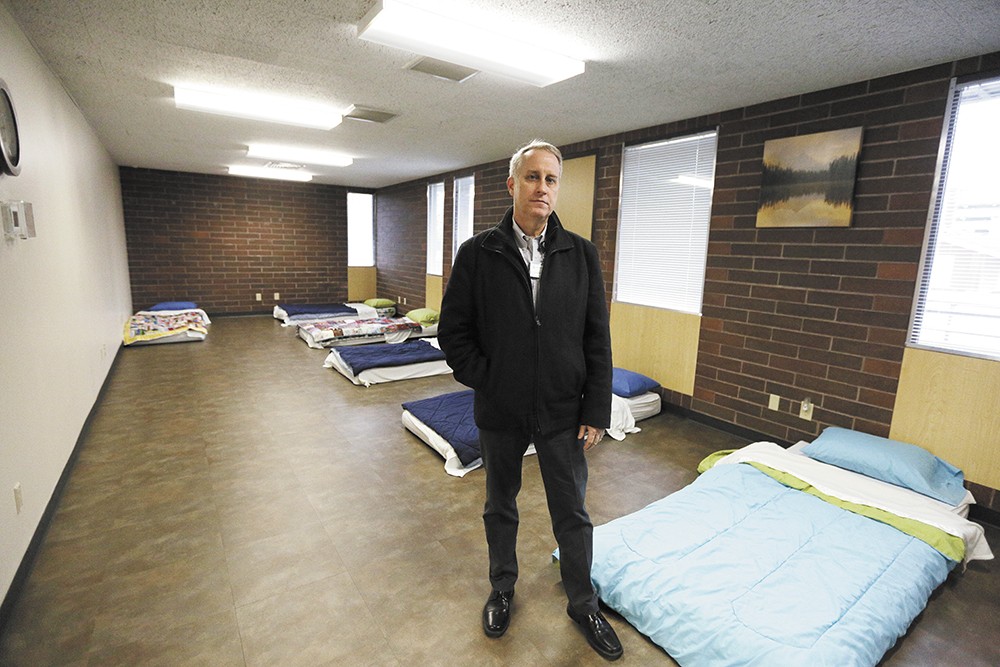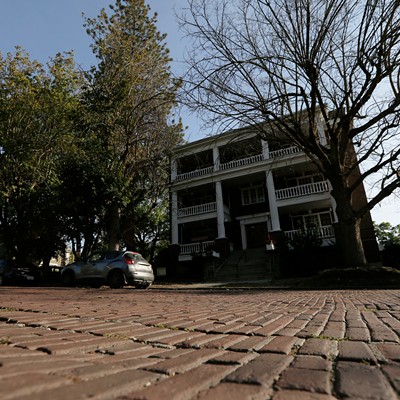
The atmosphere in the North Idaho Crisis Center building couldn't be a starker contrast to an emergency room. There's no anxiety-inducing chaos of crying babies or ringing phones or stressed family members.
Instead, it's almost silent. If a patient — here they're called "clients" — walked into the center last Friday morning, she'd find a refuge.
She could sit on the soft green couch under a big painting of a dock and a serene blue lake. She could drink coffee. She could heat up bowls of Quaker Instant Oatmeal or ramen. She could finish up the log cabin jigsaw puzzle sitting on the table. She could take a shower or brush her teeth. She'd be able to get a diagnostic medical exam, and have someone to talk to about any mental health issues.
And she could sleep. The two shared bedrooms — one for men, one for women — are spartan, little more than a few mattresses on the floor, covered with sheets and quilts.
The one catch? She can only be here for 23 hours and 59 minutes.
No, this isn't the emergency room. Rather, it's a place people can come before the crisis turns into emergency, before they're truly suicidal or truly a danger to others. Since opening on Dec. 9, the center has seen more than 140 visits.
Some are referred here by sheriff's deputies or hospital staffers, but most check themselves in, looking for sanctuary amid their battles with depression, anxiety or even homelessness.
Idaho — especially rural Idaho — has had serious deficits regarding mental health care for decades. Idaho has one of the highest suicide rates in the nation, and Kootenai County has one of the highest suicide rates in the state.
So for three years in a row, Gov. Butch Otter has dedicated a portion of his State of the State speech to call for funding for crisis centers like these. This year, he highlighted the success of the first center to open, the Behavioral Health Community Crisis Center of East Idaho.
"During the first nine months that the Idaho Falls center was open, it had more than 1,100 admissions and diverted 47 people from more expensive inpatient psychiatric care — all while saving an estimated 860 hours of law enforcement officers' time," Otter said. "I expect to see similar results from the northern Idaho crisis center."
Over the next two years, the North Idaho Crisis Center not only has to prove it's effective, it has to become financially self-sufficient. Yet, while it's only been open for little more than a month, the center has already begun to strengthen the region's mental health care system, while shedding light on existing problems.
Missing pieces
For 21 years, Don Robinson had been an FBI crisis hostage negotiator in San Diego. "I spent most of my weekends on top of the Coronado Bay bridge, doing suicide intervention," he says.
Managing the North Idaho Crisis Center, in other words, isn't such a radical career switch. This job also is about helping people who are on the edge, before the crisis gets dangerous.
"We're seeing folks who maybe haven't slept in two or three days," Robinson says. "I can get them here, get them some rest, get them some food. And after sleeping for [a few] hours, they´re in a better spot for talking about tomorrow.¨
This center was hard-won, funded in last year's budget despite some deep skepticism from some of North Idaho's conservative legislators. In 2014 and 2015, Reps. Ron Mendive, Kathy Sims and Vito Barbieri all opposed bills that included funding for the center.
As a result — as a political response to local opposition — the state gave the first crisis center to Idaho Falls, despite North Idaho narrowly edging out other regions in the state's own scoring metric for a crisis center. Part of the legislators' skepticism stemmed from the 24-hour limit: With mental health so complicated, Mendive wondered, what good could be done in only a day?
Robinson agrees that mental illness can't be fixed in a single day. That's why perhaps the most crucial role of the center's staff is that of guides, mapping out where the clients should go after their 24 hours are up.
Before, says Mike Baker, CEO of Heritage Health, a health care provider for people without insurance, patients would often be discharged from the emergency room, for example, and have no idea where to go next.
"Now, the case managers of the crisis center are calling the [Heritage Health] clinic and scheduling appointments to get [their clients] into treatment," Baker says.
The center pulls together other agencies, including health care providers, law enforcement, Idaho Department of Health and Welfare's crisis teams, and homeless shelters like the Union Gospel Mission, to assist with drawing up plans for their clients.
"We start aftercare planning the minute they hit the door," Robinson says. "What are we going to do with them tomorrow after we stabilize them?"
In asking this question, they've begun to discover the pieces that are missing from the mental health-care puzzle.
"One we're seeing right away is emergency short-term transitional housing," Robinson says. "Where is it?"
The January rain pours down on the asphalt outside.
"This is the worst thing for me," Robinson says. "The weather is just crappy enough for someone not to be good out on their own outside, but it's warm enough that the warming shelters aren't open."
Many of the people who've shown up to the crisis center have been homeless. The center isn't intended to act as a homeless shelter, but its staff is happy to assess any mental and physical health-care issues.
"We just encountered several folks who have reached that point of desperation because of their depression or the loss of a loved one," says T.J. Byrne, director of Heritage Health's homeless outreach program. "We've had folks who were so desperate, or they were lonely, or they were sleeping in their car. Something had triggered — and they went to the crisis center and would get to where they need."
What doesn't happen
The golden pen and clock sitting on Kootenai County Sheriff Ben Wolfinger's desk shows that he's been with the department for more than three decades. By now, he knows just how big a role mental health plays in crime in North Idaho.
Just the day before, Wolfinger says, sheriff's deputies visited a man they'd heard was in danger of killing himself.
"He wasn't really suicidal," Wolfinger say. "The guy told the deputies, 'I'm going through a divorce; I'm really depressed.'"
But now, with the crisis center open, Wolfinger says, the deputies had a place where they could direct the man if things got rough. Wolfinger is one of the facility's biggest champions. He's encouraged his deputies to tour the facility, and many already have. "They love having an additional resource available," he says.
Wolfinger says he's changed the policy so that if someone really needs to go to the crisis center and doesn't have a ride, one of his deputies will actually give them a ride there.
"We referred about a dozen people there," Wolfinger says. "That's about a dozen people there, where you would have been stuck in that zone between 'What do you do?' and nothing."
The struggle, Wolfinger says, is in how do you measure the savings of something that doesn't happen? If a stay at a crisis center means that there isn't an arrest or hospitalization down the road, how do you calculate the money saved?
Robinson says the legislature has given the center $1.5 million a year for the next two years for operations, but then it needs to become self-sustaining.
The results from the crisis center in Idaho Falls are promising. In their first year of operations,, the center saved the state an estimated $764,000 by helping clients who'd otherwise be racking up expensive emergency room bills, according to Idaho Department of Health and Welfare administrator Ross Edmunds.
Republican Rep. Kathy Sims of Coeur d'Alene remains skeptical. She wants to see detailed data from both active centers, clearly laid out with with the same metrics, so the costs and benefits can be accurately assessed.
For Baker, of Heritage Health, the crisis center's power goes far beyond dollars saved.
"The longer it's open, the more we see this is the right way to treat people in crisis," Baker says. "It's putting the humanity back in the process. It's awesome." ♦

























